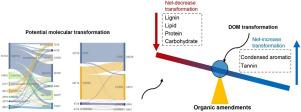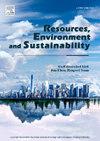Long-term organic fertilization decreases soil carbon biodegradability by mediating molecular transformation of dissolved organic matter
IF 7.8
Q1 ENVIRONMENTAL SCIENCES
引用次数: 0
Abstract
Soil dissolved organic matter (DOM), the most biogeochemically active carbon fraction, plays a critical role in regional and global carbon cycling. However, the DOM molecular transformation pathways through which long-term organic fertilization influences soil carbon stability remain poorly understood. Here, we employed carbon quantification, multiple spectroscopic techniques, and ultra-high resolution mass spectrometry to characterize the quantity and quality of soil DOM across depths of 0–20, 20–40, 40–60, 60–80, and 80–100 cm in a 35-year field experiment with chemical fertilizer (CF), cattle manure (CM), and green manure (GM). Compared to CF, CM and GM increased DOM content by 73.0%–162.8% and 81.4%–101.7%, respectively, in the 0–40 cm layers, with CM also enhancing DOM by 24.9%–69.6% in the 40–100 cm layers. DOM in organic-fertilized soils exhibited higher molecular weights and contained 23.0%–26.2% more nitrogen-containing molecular formulas than in CF-treated soils. Organic fertilization also promoted the accumulation of humic-like fluorescence components and recalcitrant compounds such as lignin-, tannin-, and condensed aromatic-like structures. Transformation network analysis showed that organic fertilization increased total number of DOM molecular transformations by 10.4%–14.1%, with positive net transformations observed in tannin- and condensed aromatic-like compounds, suggesting their formation from lignin-like and aliphatic precursors. A 28-day laboratory incubation further suggested that soil DOM under CM or GM exhibited 10.3%–13.2% lower biodegradability than CF treatment. Collectively, these findings demonstrate that long-term organic fertilization drives DOM molecular transformations toward more chemically stable assemblages, thereby reducing its biodegradability and enhancing the potential for soil carbon sequestration.

长期施用有机肥通过调节溶解有机质的分子转化降低土壤碳的可降解性
土壤溶解有机质(DOM)是生物地球化学活性最高的碳组分,在区域和全球碳循环中起着至关重要的作用。然而,长期有机施肥影响土壤碳稳定性的DOM分子转化途径尚不清楚。本研究采用碳定量、多光谱技术和超高分辨率质谱技术,对化肥(CF)、牛粪(cm)和绿肥(GM)土壤DOM在0-20、20-40、40-60、60-80和80-100 cm深度的数量和质量进行了表征。与CF相比,CM和GM在0 ~ 40 CM层的DOM含量分别提高了73.0% ~ 162.8%和81.4% ~ 101.7%,CM在40 ~ 100 CM层的DOM含量也提高了24.9% ~ 69.6%。有机肥土壤DOM分子量较高,含氮分子式比cf处理土壤高23.0% ~ 26.2%。有机施肥也促进了腐殖质样荧光成分和顽固性化合物的积累,如木质素-、单宁-和凝聚的芳香样结构。转化网络分析表明,有机肥使DOM分子转化总数增加了10.4%-14.1%,其中单宁类和缩合类芳香化合物的净转化为正,表明它们是由木质素类和脂肪族前体形成的。28天的室内培养进一步表明,CM或GM处理下土壤DOM的生物降解性比CF处理低10.3% ~ 13.2%。综上所述,这些发现表明,长期有机施肥会促使DOM分子向更稳定的化学组合转变,从而降低其生物降解性,增强土壤固碳潜力。
本文章由计算机程序翻译,如有差异,请以英文原文为准。
求助全文
约1分钟内获得全文
求助全文
来源期刊

Resources Environment and Sustainability
Environmental Science-Environmental Science (miscellaneous)
CiteScore
15.10
自引率
0.00%
发文量
41
审稿时长
33 days
 求助内容:
求助内容: 应助结果提醒方式:
应助结果提醒方式:


